- Home
- Ernest Hemingway
Death in the Afternoon Page 12
Death in the Afternoon Read online
Page 12
Bulls that are to be used in breeding are tested with greatest rigor. After they have been used for breeding for some years if they are then sent to the ring you may always recognize them. They seem to know all about the picadors. They will charge bravely often, but will be able to knock the pic out of the man's hand with their horns, and I have seen one ignoring pic and horse, reach up and hook the man out of the saddle. If they have, too, been tested with cape and muleta they become, often, absolutely unkillable, and a bullfighter who has signed a contract to kill two "new bulls" is perfectly within his rights to refuse these bulls or to kill these learnéd animals in any way that he can. By law every bull that has appeared in the ring must be killed immediately thereafter to prevent bulls being used more than once. But this law is often broken in the provinces, and is always broken in capeas or amateur fights which have long been forbidden by law. A stud-bull that has been thoroughly tested has not the skill of these criminals, but he has been obviously fought before and any intelligent spectator can see the difference at once. In the testing of bulls it is important not to confuse the power of the young bull with his bravery. A bull may be strong enough in a single charge, if the pic should slip, to overthrow the rider and mount and make a fine showing while, if the pic should have held firm, he might have been quiet under the punishment, refused to insist and finally turned his head. Bulls are tested in corrals in Castilla, the country around Salamanca, Navarra and Extremadura, but in Andalucía they are usually tested in the open range.
Those who advocate testing in the open say that the true bravery of a bull can only be shown that way since in the corral he feels himself cornered, and any cornered animal will fight. In open-range testing though, the bulls are ridden after until they turn; are toppled by the long poles carried by the horsemen or are roused in some way before they charge the picador, while in the corral they are let absolutely alone and harassed in no way; so the two ways are about equal in advantage; the testing on the open range, with a crowd of mounted guests, is more picturesque, and the corral method is nearer to approximating the actual conditions of the bull ring.
All of the operations of bull raising to one who loves bullfighting are of great fascination and in the testings one has much eating, drinking, companionship, practical joking, bad amateur cape-work by the aristocracy, often excellent amateur cape-work by the visiting bootblacks who aspire to be matadors, and long days with the smell of cold, fall air, of dust and leather and lathered horses, and the big bulls not so far away looking very big in the fields, calm and heavy, and dominating the landscape with their confidence.
Fighting bulls are raised in the provinces of Navarra, Burgos, Palencia, Logrono, Zaragoza, Vallodolid, Zamora, Segovia, Salamanca, Madrid, Toledo, Albacete, Extremadura and Andalucia, but the principal regions are Andalucia, Castilla, and Salamanca. The biggest bulls and the best bred come from Andalucía and Castilla, and those which are made nearest to order for the bullfighters from Salamanca. Navarra still raises many bulls, but their cast, type and bravery have deteriorated greatly in the last twenty years.
All brave bulls may be roughly divided into two classes: those that are made, bred and created for bullfighters, and those that are bred to please their breeders. Salamanca stands at one extreme and Andalucia at the other.
But, you say, there is very little conversation in this book. Why isn't there more dialogue? What we want in a book by this citizen is people talking; that is all he knows how to do and now he doesn't do it. The fellow is no philosopher, no savant, an incompetent zoologist, he drinks too much and cannot punctuate readily and now he has stopped writing dialogue. Some one ought to put a stop to him. He is bull crazy. Citizen, perhaps you are right. Let us have a little dialogue.
What do you ask, Madame? Is there anything you would like to know about the bulls?
Yes, sir.
What would you like to know? I'll tell you absolutely anything.
It is a difficult thing to ask, sir.
Do not let that trouble you; talk to me frankly; as you would to your doctor, or to another woman. Do not be afraid to ask what you would really like to know.
Sir, I would like to know about their love life.
Madame, you have come to just the man.
Then tell me, sir.
Madame, I will. It is as good a subject as another. It combines popular appeal, a touch of sex, a world of useful information and it lends itself to dialogue. Madame, their love lives are tremendous.
I had thought as much, sir, but can you not give us some statistics?
Most readily. The little calves are born in the winter months.
It was not of the little calves that we wished most to hear.
But you must be patient, Madame. All these things but lead to the little calves and so, indeed, they must be taken to start from them too. The little calves are born in three months of the winter and, counting backward nine months on your fingers as who, being married, has not counted forward nine months on their fingers many times, you find that if the calves are born in December, January and February the bulls have been let run with the cows during April. May and June when, as a fact, they most usually are. In a good ranch there are from two hundred to four hundred cows and for every fifty cows there is one bull. The usual ranch has two hundred cows and four seed bulls. These bulls are from three to five years old and older. When a bull is first turned loose with the cows no one knows how he will act, although were a bookmaker present he would lay you odds that the bull would show enthusiasm for his companions. But sometimes a bull will have nothing to do with them nor they with him and they will fight savagely with their horns making a clatter of horn on horn you can hear across the field. Sometimes such a bull will change his attitude toward one of the cows, but this is rare. At other times the bulls range quietly with the cows but will leave them to return to the other bulls, who, being destined for the ring, are never let run with the cows at all. But the ordinary result is that which the bookmaker would lay you odds would occur, and a single bull would do for more than fifty cows, but if there were too many he would finally weaken and end in impotence. Are these the facts you care to hear or do I speak too baldly?
No one could say, sir, you place the facts in any but a straightforward Christian way and we find them most instructive.
This gratifies me and I will tell you of an odd occurrence. The bull is polygamous as an animal, but occasionally an individual is found that is monogamous. Sometimes a bull on the range will come to so care for one of the fifty cows that he is with that he will make no case of all the others and will only have to do with her and she will refuse to leave his side on the range. When this occurs they take the cow from the herd and if the bull does not then return to polygamy he is sent with the other bulls that are for the ring.
I find that a sad story, sir.
Madame, all stories, if continued far enough, end in death, and he is no true-story teller who would keep that from you. Especially do all stories of monogamy end in death, and your man who is monogamous while he often lives most happily, dies in the most lonely fashion. There is no lonelier man in death, except the suicide, than that man who has lived many years with a good wife and then outlived her. If two people love each other there can be no happy end to it.
Sir, I do not know what you mean by love. It does not sound well as you say it.
Madame, it is an old word and each one takes it new and wears it out himself. It is a word that fills with meaning as a bladder with air and the meaning goes out of it as quickly. It may be punctured as a bladder is punctured and patched and blown up again and if you have not had it it does not exist for you. All people talk of it, but those who have had it are all marked by it and I would not wish to speak of it further since of all things it is the most ridiculous to talk of and only fools go through it many times. I would sooner have the pox than to fall in love with another woman loving the one I have.
What has this to do with the bulls, sir?
Nothing
, Madame, nothing at all, it is only conversation to give you your money's worth.
I find the subject interesting. What way are people marked who have had this thing or is that only a way of speaking?
All those who have really experienced it are marked, after it is gone, by a quality of deadness. I say this as a naturalist, not to be romantic.
This does not amuse me.
Nor is it designed to, Madame, but only to give you your money's worth.
But often you amuse me very much.
Madame, with a little luck I will amuse you again.
CHAPTER TWELVE
No one can say, on seeing a fighting bull in the corrals, whether that bull will be brave in the ring although, usually, the quieter the bull is, the less nervous he seems, the calmer he is, the more chance that he will turn out brave. The reason for this is that the braver he is, usually, the more confident he is and the less he bluffs. All supposed exterior signs of danger that a bull gives, such as pawing the ground, threatening with his horns, or bellowing are forms of bluffing. They are warnings given in order that combat may be avoided if possible. The truly brave bull gives no warning before he charges except the fixing of his eye on his enemy, the raising of the crest of muscle in his neck, the twitching of an ear, and, as he charges, the lifting of his tail. A completely brave bull, if he is in perfect condition will never open his mouth, will not even let his tongue out, during the course of the entire fight and, at the finish, with the sword in him, will come toward the man while his legs support him, his mouth tight shut to keep the blood in.
Now what makes a bull brave is first the strain of fighting blood which can only be kept pure by conscientious testing in the tientas and second his own health and condition. Health and condition will not replace scrupulous breeding, but lack of them will ruin the natural inherited bravery of an animal, will make his body incapable of responding to it, or else cause the bravery to burn up as a fire of straw, burning out in a single flare and the bull being then empty and hollow. Health and condition are determined, granting there has been no disease on the ranch, by pasture and water.
It is the differences of pasture and water in different parts of Spain caused by the different climates, the changes in composition of the soil and the distances the stock must go to water from their pastures that make entirely different types of bulls. Spain is more a continent than a country in regard to climates, for the climate and vegetation of the north, of Navarra for example, has nothing in common with that of Valencia or Andalucia and none of those three, except parts of Navarra, have any resemblance to the high plateau of Castilla. So the bulls raised in Navarra, Andalucia and Salamanca differ greatly, and this is not due to them coming from differing strains. Navarrese bulls are almost a different race, smaller and usually of a reddish color, but when bull raisers in Navarra have taken seed bulls and cows from an Andalucian ranch and tried to transplant them to Navarra they have invariably taken on the present vices of the northern bulls, nervousness, uncertainty in attack and lack of true bravery, and have lost their original character without gaining any of the quickness, courage and deerlike speed that characterized the old strains of Navarra. Bulls in Navarra are about bred out due to inbreeding of the original Navarrese strain and the selling of their best cows to France a number of years ago for use in the Course Landaise, a French form of bull fête, and the inability of the Andalucian and Castillian strains to retain their type and bravery on the northern ranges although many costly experiments have been made to develop a new and brave Navarrese strain. The best fighting bulls come from Andalucia, Colmenar, Salamanca, and, exceptionally, Portugal. The most typical bulls are those of Andalucia. The Andalucian breeds have been taken to Salamanca and perverted by breeding them down in size and in length of horn in order to please the bullfighters. Salamanca is an ideal province for bull breeding. The pastures and water are good and the bulls from there are sold at under four years and often, to make them appear larger and older, are fed on grain for a time which gives them a false size, covering the natural muscle with fat, giving them a false well-being, causing them to tire quickly and to be short of wind. Many bulls from Salamanca, if fought at four and one-half to five years, hence having their natural size and not needing to be fed up on grain to reach the government-required poundage, with a year more on the range and the consequent added maturity, would be the ideal fighting bulls except for a tendency that they have to lose frankness and bravery when they have passed their fourth year. Occasionally you will see such a corrida in Madrid, but on the publicity they receive from such a splendid lot of bulls and with the aid and connivances of the bullfighters the same breeders that send such an ideal corrida to the capital will sell fifteen or twenty other corridas throughout the provinces in a season which will be composed of bulls under the minimum age, stuffed on grain to make them seem big, giving the minimum of danger because of their lack of experience in using their horns, and helping in every way, by depriving the spectacle of that which makes it, the true fighting bull, to contribute to the decadence of bullfighting.
For the third factor in the making of a bull, after breeding and condition, is age. With any one of these three factors lacking you cannot have a complete fighting bull. A bull is not mature until after his fourth year. It is true that after his third year he looks mature, but he is not. Maturity brings strength, resistance, but above all, knowledge. Now the knowledge of a bull consists principally in his memory of experience, he forgets nothing, and in his knowledge of, and ability to use, his horns. It is the horn that makes bullfighting and the ideal bull is one whose memory is as clean as possible from any experience of bullfighting so that he will learn everything that he is to learn in the ring; being dominated if the bullfighter works him properly, and dominating the bullfighter if his work is deficient or cowardly; and for this bull to provide the most real danger and put the bullfighter to the necessary test of knowledge of how to handle a bull properly he must know how to use his horns. At four years a bull has this knowledge, he has acquired it by fighting on the range, the only way he can acquire it. To see two bulls fight is a beautiful sight. They use their horns as a fencer does his weapon. They strike, parry, feint, block, and have an exactitude of aim that is amazing. When they both know how to use the horn the combat usually ends as does a fight between two really skillful boxers, with all dangerous blows stopped, without bloodshed and with mutual respect. They do not have to kill each other for a decision. The bull that loses is the first one that breaks and turns acknowledging the other's superiority. I have seen them fight again and again for small causes that I was not able to make out; coming head on, feinting with their master horn, the horns clattering as they knocked together, the blows being parried and countered, then, suddenly one bull would wheel and turn and gallop off. Once though, in the corrals after a fight in which one bull turned away admitting he was beaten, the other followed him and charged, getting the horn in the defeated bull's flank and throwing him over. Before the bull that was down could get to his feet the other was on him, driving the horn in with chopping thrusts of his neck and head; driving in all the time. The defeated bull got to his feet once, wheeled to face head-on, but in the first horn exchange he was caught in the eye, then went down under another charge. The bull killed him without letting him get to his feet again. Before the fight, two days later, that same bull killed another in the corrals, but when he came into the ring he was one of the best animals, both for bullfighters and public, that I have ever seen. His horn knowledge had been acquired as it should be. He had no vices with the horn, he simply knew how to use it, and the matador, Felix Rodriguez, dominated him, did splendid work with the cape and muleta and killed him perfectly.
A three-year-old bull may know how to use his horns, but it is exceptional. He has not had enough experience. Bulls over five years know too well how to use their armament. They have had so much experience and become so skilled with the horn that the necessity for overcoming and watching out for this makes
it almost impossible for the bullfighter to do anything brilliant. They make an interesting fight, but you need a thorough knowledge of bullfighting to appreciate the matadors' work. Nearly every bull has one horn that he prefers to use more than the other and this horn is called the master horn. They are often almost as right or left horned as people are right or left handed, but there is no such preponderance in favor of the right horn. One is as liable to be the master as the other. You may see which horn is the master when the banderilleros run the bull with the cape at the start of the fight, but there is another way you can often tell. A bull when he is about to charge, or when he is angry, twitches one or, occasionally, both ears. The ear that he twitches is usually on the side of the horn that he uses for preference.
Bulls vary greatly in the way they use their horns; some are called assassins from the way in which, attacking the picadors, they will not give a single chop until they are sure of their range; then when they are close, driving the horn into the vulnerable part of the horse with the surety of a dagger stroke. Such bulls have usually attacked a herder or killed a horse previously at some time on the range, and they remember how it is done. They do not charge from a distance and try to overthrow horse and man, but only to get in under the picador in some way, often chopping at the shaft of the pole with their horns, so they can place their horn stroke. For this reason the number of horses killed by a bull may not be an indication of his bravery nor of his power, for a bull with a deadly horn will kill horses where a braver, more powerful bull will, perhaps, only overthrow horse and rider, and, in his violence, aim scarcely at all with the horn.

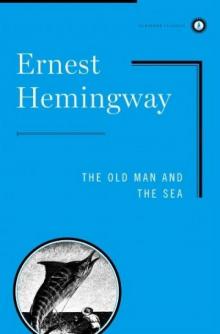 The Old Man and the Sea
The Old Man and the Sea Green Hills of Africa
Green Hills of Africa The Sun Also Rises
The Sun Also Rises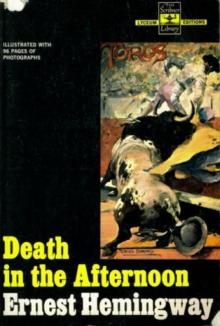 Death in the Afternoon
Death in the Afternoon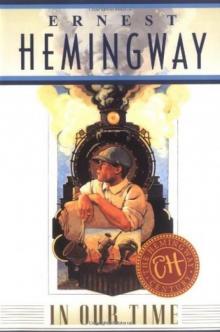 In Our Time
In Our Time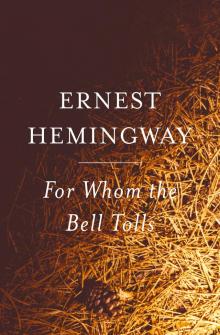 For Whom the Bell Tolls
For Whom the Bell Tolls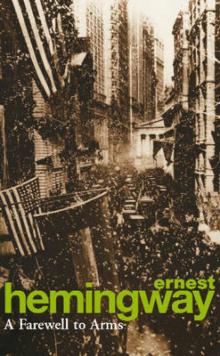 A Farewell to Arms
A Farewell to Arms A Moveable Feast
A Moveable Feast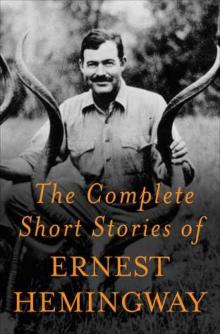 The Complete Short Stories of Ernest Hemingway
The Complete Short Stories of Ernest Hemingway Big Two-Hearted River
Big Two-Hearted River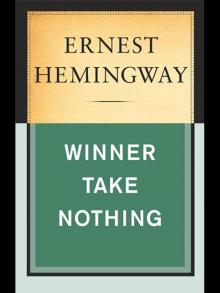 Winner Take Nothing
Winner Take Nothing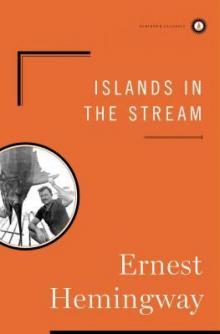 Islands in the Stream
Islands in the Stream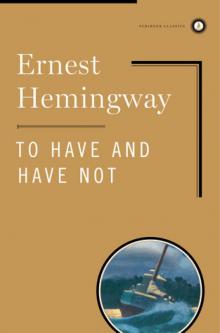 To Have and Have Not
To Have and Have Not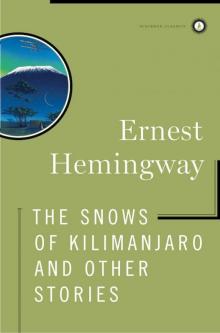 The Snows of Kilimanjaro and Other Stories
The Snows of Kilimanjaro and Other Stories Across the River and Into the Trees
Across the River and Into the Trees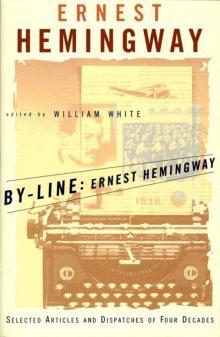 By-Line Ernest Hemingway
By-Line Ernest Hemingway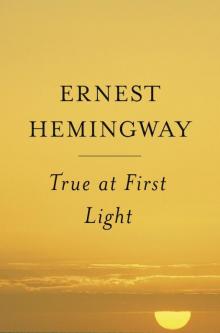 True at First Light
True at First Light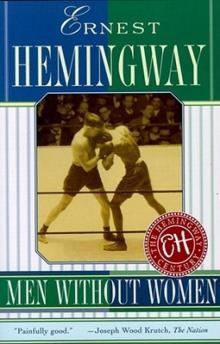 Men Without Women
Men Without Women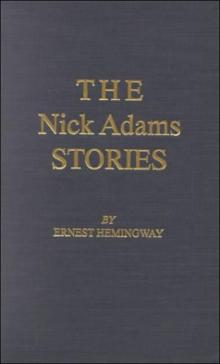 The Nick Adams Stories
The Nick Adams Stories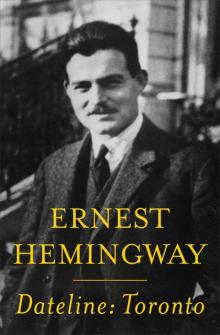 Dateline- Toronto
Dateline- Toronto The Torrents of Spring
The Torrents of Spring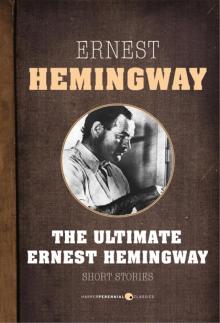 Short Stories
Short Stories